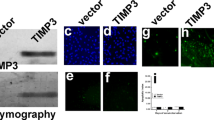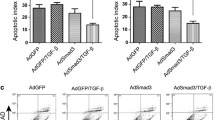Abstract
Small tumor vessels are composed of endothelial cells (ECs) and vascular smooth muscle cells (VSMCs). These cells have been shown to communicate with each other via cytokine signaling during neovascularization. We previously demonstrated that interleukin-1β (IL-1β) leads to induction of vascular endothelial growth factor (VEGF) in human colon carcinoma cells. As pericytes play a role in regulating EC function, we hypothesized that IL-1β may mediate EC survival by induction of VEGF in a paracrine manner. We investigated the effects of IL-1β on VEGF expression in human VSMCs (hVSMCs) and the signal transduction pathways that may be involved. Treatment of hVSMCs with IL-1β induced VEGF expression in a time- and concentration-dependent manner and increased both the VEGF promoter activity and the mRNA half-life. Treatment with IL-1β induced the expression of P38 mitogen-activated protein kinase (MAPK) within 5 min but did not activate extracellular signal-regulated kinases (Erk)-1/2, c-jun amino terminal kinase (JNK), or Akt. SB203580, a specific P38 MAPK inhibitor, blocked the ability of IL-1β to induce VEGF mRNA and promoter activity. Conditioned media from hVSMCs pretreated with IL-1β prevented apoptosis of ECs, an effect that was partially abrogated by VEGF-neutralizing antibodies. These data demonstrate that IL-1β may induce VEGF in hVSMCs, and suggest that this paracrine signaling pathway, may prevent, in part, apoptosis of ECs.
Similar content being viewed by others
References
Folkman J. Angiogenesis in cancer, vascular, rheumatoid and other disease. Nat Med 1995; 1: 27–31.
Takahashi Y, Kitadai Y, Bucana CD et al. Expression of vascular endothelial growth factor and its receptor, KDR, correlates with vascularity, metastasis, and proliferation of human colon cancer. Cancer Res 1995; 55: 3964–8.
Brown LF, Berse B, Jackman RW et al. Expression of vascular permeability factor (vascular endothelial growth factor) and its receptors in adenocarcinomas of the gastrointestinal tract. Cancer Res 1993; 53: 4727–35.
Brown LF, Berse B, Jackman RW et al. Increased expression of vascular permeability factor (vascular endothelial growth factor) and its receptors in kidney and bladder carcinomas. Am J Pathol 1993; 143: 1255–62.
Toi M, Kashitani J, Tominaga T. Tumor angiogenesis is an independent prognostic indicator in primary breast carcinoma. Int J Cancer 1993; 55: 371–4.
Tanigawa N, Amaya H, Matsumura M, Shimomatsuya T. Correlation between expression of vascular endothelial growth factor and tumor vascularity, and patient outcome in human gastric carcinoma. J Clin Oncol 1997; 15: 826–32.
Ferrara N. Molecular and biological properties of vascular endothelial growth factor. J Mol Med 1999; 77: 527–43.
Bruns CJ, Liu W, Davis DW et al. Vascular endothelial growth factor is an in vivo survival factor for tumor endothelium in a murine model of colorectal carcinoma liver metastases. Cancer 2000; 89: 488–99.
Benjamin LE, Golijanin D, Itin A et al. Selective ablation of immature blood vessels in established human tumors follows vascular endothelial growth factor withdrawal [see comments]. J Clin Invest 1999; 103: 159–65.
Gerber HP, Dixit V, Ferrara N. Vascular endothelial growth factor induces expression of the antiapoptotic proteins Bcl-2 and A1 in vascular endothelial cells. J Biol Chem 1998; 273: 13313–6.
Tran J, Rak J, Sheehan C et al. Marked induction of the IAP family antiapoptotic proteins survivin and XIAP by VEGF in vascular endothelial cells. Biochem Biophys Res Commun 1999; 264: 781–8.
Nor JE, Christensen J, Mooney DJ, Polverini PJ. Vascular endothelial growth factor (VEGF)-mediated angiogenesis is associated with enhanced endothelial cell survival and induction of Bcl-2 expression. Am J Pathol 1999; 154: 375–84.
Pertovaara L, Kaipainen A, Mustonen T et al. Vascular endothelial growth factor is induced in response to transforming growth factor-beta in fibroblastic and epithelial cells. J Biol Chem 1994; 269: 6271–4.
Li J, Perrella MA, Tsai JC et al. Induction of vascular endothelial growth factor gene expression by interleukin-1 beta in rat aortic smooth muscle cells. J Biol Chem 1995; 270: 308–12.
Namiki A, Brogi E, Kearney M et al. Hypoxia induces vascular endothelial growth factor in cultured human endothelial cells. J Biol Chem 1995; 270: 31189–95.
Maniscalco WM, Watkins RH, Finkelstein JN, Campbell MH. Vascular endothelial growth factor mRNA increases in alveolar epithelial cells during recovery from oxygen injury. Am J Respir Cell Mol Biol 1995; 13: 377–86.
McLaren J, Prentice A, Charnock-Jones DS et al. Vascular endothelial growth factor is produced by peritoneal fluid macrophages in endometriosis and is regulated by ovarian steroids. J Clin Invest 1996; 98: 482–9.
Shima DT, Deutsch U, D'Amore PA. Hypoxic induction of vascular endothelial growth factor (VEGF) in human epithelial cells is mediated by increases in mRNA stability. FEBS Lett 1995; 370: 203–8.
Mazure NM, Chen EY, Laderoute KR, Giaccia AJ. Induction of vascular endothelial growth factor by hypoxia is modulated by a phosphatidylinositol 3-kinase/Akt signaling pathway in Ha-ras-transformed cells through a hypoxia inducible factor-1 transcriptional element. Blood 1997; 90: 3322–31.
Levy AP, Levy NS, Wegner S, Goldberg MA. Transcriptional regulation of the rat vascular endothelial growth factor gene by hypoxia. J Biol Chem 1995; 270: 13333–40.
Levy AP, Levy NS, Goldberg MA. Post-transcriptional regulation of vascular endothelial growth factor by hypoxia. J Biol Chem 1996; 271: 2746–53.
Cohen T, Nahari D, Cerem LW et al. Interleukin 6 induces the expression of vascular endothelial growth factor. J Biol Chem 1996; 271: 736–41.
Stavri GT, Hong Y, Zachary IC et al. Hypoxia and platelet-derived growth factor-BB synergistically upregulate the expression of vascular endothelial growth factor in vascular smooth muscle cells. FEBS Lett 1995; 358: 311–5.
Dolecki GJ, Connolly DT. Effects of a variety of cytokines and inducing agents on vascular permeability factor mRNA levels in U937 cells. Biochem Biophys Res Commun 1991; 180: 572–8.
Stavri GT, Zachary IC, Baskerville PA et al. Basic fibroblast growth factor upregulates the expression of vascular endothelial growth factor in vascular smooth muscle cells. Synergistic interaction with hypoxia. Circulation 1995; 92: 11–4.
Silvagno F, Follenzi A, Arese M et al. In vivo activation of met tyrosine kinase by heterodimeric hepatocyte growth factor molecule promotes angiogenesis. Arterioscler Thromb Vasc Biol 1995; 15: 1857–65.
Jung YD, Nakano K, Liu W et al. Extracellular signal-regulated kinase activation is required for up-regulation of vascular endothelial growth factor by serum starvation in human colon carcinoma cells. Cancer Res 1999; 59: 4804–7.
Mukhopadhyay D, Tsiokas L, Zhou XM et al. Hypoxic induction of human vascular endothelial growth factor expression through c-Src activation. Nature 1995; 375: 577–81.
Rak J, Mitsuhashi Y, Bayko L et al. Mutant ras oncogenes upregulate VEGF/VPF expression: implications for induction and inhibition of tumor angiogenesis. Cancer Res 1995; 55: 4575–80.
Goede V, Schmidt T, Kimmina S et al. Analysis of blood vessel maturation processes during cyclic ovarian angiogenesis. Lab Invest 1998; 78: 1385–94.
Mukhopadhyay D, Tsiokas L, Sukhatme VP. High cell density induces vascular endothelial growth factor expression via protein tyrosine phosphorylation. Gene Expr 1998; 7: 53–60.
Koura AN, Liu W, Kitadai Y et al. Regulation of vascular endothelial growth factor expression in human colon carcinoma cells by cell density. Cancer Res 1996; 56: 3891–4.
Conrad PW, Rust RT, Han J et al. Selective activation of p38alpha and p38gamma by hypoxia. Role in regulation of cyclin D1 by hypoxia in PC12 cells. J Biol Chem 1999; 274: 23570–6.
Berse B, Brown LF, Van de Water L et al. Vascular permeability factor (vascular endothelial growth factor) gene is expressed differentially in normal tissues, macrophages, and tumors. Mol Biol Cell 1992; 3: 211–20.
Pal S, Claffey KP, Cohen HT, Mukhopadhyay D. Activation of Sp1-mediated vascular permeability factor/vascular endothelial growth factor transcription requires specific interaction with protein kinase C zeta. J Biol Chem 1998; 273: 26277–80.
Akagi Y, Liu W, Zebrowski B et al. Regulation of vascular endothelial growth factor expression in human colon cancer by insulin-like growth factor-1. Cancer Res 1998; 58: 4008–14.
Tartakovsky B, Kovacs EJ, Takacs L, Durum SK. T cell clone producing an IL 1-like activity after stimulation by antigen-presenting B cells. J Immunol 1986; 137: 160–6.
Takahashi Y, Bucana CD, Liu W et al. Platelet-derived endothelial cell growth factor in human colon cancer angiogenesis: Role of infiltrating cells [see comments]. J Natl Cancer Inst 1996; 88: 1146–51.
Polverini PJ, Leibovich SJ. Induction of neovascularization in vivo and endothelial proliferation in vitro by tumor-associated macrophages. Lab Invest 1984; 51: 635–42.
Leek RD, Lewis CE, Whitehouse R et al. Association of macrophage infiltration with angiogenesis and prognosis in invasive breast carcinoma. Cancer Res 1996; 56: 4625–9.
Nishie A, Ono M, Shono T et al. Macrophage infiltration and heme oxygenase-1 expression correlate with angiogenesis in human gliomas. Clin Cancer Res 1999; 5: 1107–13.
Libby P, Warner SJ, Friedman GB. Interleukin 1: A mitogen for human vascular smooth muscle cells that induces the release of growth-inhibitory prostanoids. J Clin Invest 1988; 81: 487–98.
Mantovani A, Bussolino F, Dejana E. Cytokine regulation of endothelial cell function. FASEB J 1992; 6: 2591–9.
Koch AE, Polverini PJ, Kunkel SL et al. Interleukin-8 as a macrophage-derived mediator of angiogenesis [see comments]. Science 1992; 258: 1798–801.
Gutman M, Singh RK, Xie K et al. Regulation of interleukin-8 expression in human melanoma cells by the organ environment. Cancer Res 1995; 55: 2470–5.
Cobb MH, Goldsmith EJ. How MAP kinases are regulated. J Biol Chem 1995; 270: 14843–6.
Brewster JL, de Valoir T, Dwyer ND et al. An osmosensing signal transduction pathway in yeast. Science 1993; 259: 1760–3.
Gupta K, Kshirsagar S, Li W et al. VEGF prevents apoptosis of human microvascular endothelial cells via opposing effects on MAPK/ERK and SAPK/JNK signaling. Exp Cell Res 1999; 247: 495–504.
Hirschi KK, Rohovsky SA, Beck LH et al. Endothelial cells modulate the proliferation of mural cell precursors via platelet-derived growth factor-BB and heterotypic cell contact. Circ Res 1999; 84: 298–305.
Tischer E, Mitchell R, Hartman T, Silva M et al. The human gene for vascular endothelial growth factor. Multiple protein forms are encoded through alternative exon splicing. J. Biol. Chem 1991; 266: 11947–54.
Mazure NM, Chen EY, Laderoute KR, Giaccia AJ. Induction of vascular endothelial growth factor by hypoxia is modulated by a phosphatidylinositol 3-kinase/Akt signaling pathway in Ha-ras-transformed cells through a hypoxia inducible factor-1 transcriptional element. Blood 1997; 90: 3322–31.
Rolli M, Kotlyarov A, Sakamoto KM et al. Stress-induced stimulation of early growth response gene-1 by p38/stress-activated protein kinase 2 is mediated by a cAMP-responsive promoter element in a MAPKAP kinase 2-independent manner. J Biol Chem 1999; 274: 19559–64.
Yang SH, Whitmarsh AJ, Davis RJ, Sharrocks AD. Differential targeting of MAP kinases to the ETS-domain transcription factor Elk-1.EMBO J 1998; 17: 1740–9.
Novotny V, Prieschl EE, Csonga R et al. Nrfl in a complex with fosB, c-jun, junD and ATF2 forms the AP1 component at the TNF alpha promoter in stimulated mast cells. Nucleic Acids Res 1998; 26: 5480–5.
Author information
Authors and Affiliations
Rights and permissions
About this article
Cite this article
Jung, Y.D., Liu, W., Reinmuth, N. et al. Vascular endothelial growth factor is upregulated by interleukin-1β in human vascular smooth muscle cells via the P38 mitogen-activated protein kinase pathway. Angiogenesis 4, 155–162 (2001). https://doi.org/10.1023/A:1012291524723
Issue Date:
DOI: https://doi.org/10.1023/A:1012291524723




